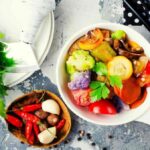Embark on a culinary journey through the vibrant world of Middle Eastern cuisine, where bold flavors reign supreme, even without the reliance on excessive salt. This exploration unveils a treasure trove of naturally low-sodium dishes, revealing how traditional recipes can be adapted to create healthier, equally delicious meals. We’ll uncover the secrets to unlocking the inherent tastes of ingredients, using herbs, spices, and citrus to craft an unforgettable dining experience that prioritizes both flavor and well-being.
From fragrant grilled meats and vibrant vegetable tagines to refreshing salads and flavorful dips, we’ll guide you through a collection of recipes that showcase the versatility and depth of Middle Eastern cuisine. Learn to skillfully substitute ingredients, employing healthy alternatives that maintain texture and taste while significantly reducing sodium intake. Discover the art of enhancing flavors through cooking techniques and creative spice blends, transforming classic dishes into lighter, healthier versions that will leave you feeling satisfied and energized.
Popular Low-Sodium Middle Eastern Dishes

Embarking on a culinary journey through the Middle East doesn’t necessitate a high-sodium diet. Many traditional dishes, with their emphasis on fresh herbs, vibrant vegetables, and aromatic spices, are naturally low in sodium or easily adaptable to become so. By understanding the flavor profiles and making simple substitutions, you can enjoy the rich tapestry of Middle Eastern cuisine without compromising your health.
Naturally Low-Sodium Middle Eastern Dishes
Several popular Middle Eastern dishes inherently boast low sodium content, relying instead on the complex interplay of fresh ingredients and traditional spices to deliver a burst of flavor. These dishes showcase the region’s culinary artistry, highlighting the natural goodness of its produce.
- Muhammara: This vibrant red pepper dip, a staple in Levantine cuisine, bursts with the sweetness of roasted red peppers, the tang of pomegranate molasses, and the nutty depth of walnuts. Its naturally low sodium content is amplified by the absence of added salt, relying entirely on the inherent flavors of its components. Imagine the deep crimson hue, speckled with the golden flecks of walnuts, a visual testament to its rich flavor profile.
- Fattoush: A refreshing salad featuring crisp lettuce, tomatoes, cucumbers, and toasted pita bread, fattoush is a symphony of textures and tastes. The zesty lemon-sumac dressing, traditionally made without added salt, binds the ingredients together, creating a light and flavorful dish. Picture the contrasting colors – the deep green of the lettuce, the vibrant red of the tomatoes, the pale green of the cucumbers, all brought together by the golden-brown croutons.
- Tabbouleh: This herbaceous salad, a cornerstone of Lebanese cuisine, is a testament to the power of fresh parsley. Finely chopped parsley forms the base, interwoven with bulgur wheat, mint, and a simple lemon dressing. The refreshing coolness of the parsley, combined with the subtle earthiness of the bulgur, creates a light and invigorating dish naturally low in sodium. The vibrant green of the parsley is almost luminous, contrasting beautifully with the lighter tones of the bulgur.
- Baba Ghanoush: This creamy eggplant dip, a staple across the Middle East, relies on the smoky sweetness of roasted eggplant, the tang of tahini, and the bright acidity of lemon juice. Traditionally, minimal salt is used, allowing the natural flavors of the eggplant to shine through. Imagine the smooth, almost silken texture, the deep purple hue punctuated by swirls of creamy tahini, a visual representation of its rich and complex flavor.
- Hummus (with modifications): While traditional hummus can be higher in sodium due to added salt, a homemade version allows for precise control. By using unsalted tahini and minimizing added salt, you can significantly reduce the sodium content without sacrificing the creamy texture and nutty flavor. Picture the pale beige color, almost ivory in its smoothness, hinting at the subtle flavors within.
Adapting High-Sodium Middle Eastern Dishes
Many beloved Middle Eastern dishes, while delicious, often contain higher-than-ideal sodium levels due to the use of preserved ingredients or heavy salting. However, simple adjustments can dramatically reduce sodium content without compromising the overall taste.
- Reduce or eliminate added salt: The most straightforward approach is to reduce or eliminate added salt entirely. Taste the dish throughout the cooking process and adjust seasonings with herbs, spices, lemon juice, or vinegar.
- Use low-sodium or unsalted ingredients: Opt for low-sodium or unsalted canned beans, vegetable broth, and other packaged ingredients. Fresh herbs and spices can add depth of flavor without added sodium.
- Rinse canned ingredients: Rinsing canned beans, chickpeas, or tomatoes under cold water can significantly reduce their sodium content. This simple step removes a surprising amount of excess salt.
- Increase the volume of fresh vegetables: Adding more fresh vegetables to stews, soups, or other dishes can dilute the sodium concentration and add nutritional value. The increased volume of fresh ingredients contributes to a more balanced flavor profile.
- Experiment with alternative seasonings: Explore a wider range of spices and herbs to enhance the flavor of your dishes. Sumac, za’atar, turmeric, and cumin are excellent choices for adding depth and complexity without added sodium.
Sodium Content Comparison: Traditional vs. Adapted Recipes
| Dish | Traditional Sodium (mg/serving) (Estimate) | Adapted Sodium (mg/serving) (Estimate) | Adaptation Method |
|---|---|---|---|
| Hummus | 300-400 | 100-150 | Unsalted tahini, reduced salt |
| Baba Ghanoush | 150-200 | 50-100 | Reduced salt, increased lemon juice |
| Chicken Shawarma (with modifications) | 500-600 | 200-300 | Reduced salt in marinade, use of fresh herbs and spices |
| Lentil Soup | 350-450 | 150-200 | Low-sodium broth, reduced salt, increased vegetables |
| Falafel (with modifications) | 250-350 | 100-150 | Reduced salt in the chickpea mixture, increased herbs and spices |
Healthy Ingredient Substitutions
Embarking on a culinary journey through the vibrant flavors of Middle Eastern cuisine doesn’t necessitate compromising on health. Many traditional ingredients can be easily swapped for healthier, lower-sodium alternatives, preserving the authentic taste while enhancing the nutritional profile of your dishes. This section explores suitable replacements for common ingredients, emphasizing the nutritional advantages and practical application in recipes.
Careful ingredient selection is crucial for maintaining a balanced diet, especially when managing sodium intake. The following substitutions provide a delicious pathway to enjoying flavorful Middle Eastern food while promoting overall well-being. We will examine the nutritional benefits of each substitute and offer practical advice for seamless integration into your favorite recipes.
Salt Substitutes and Their Nutritional Benefits
Salt, while essential for flavor, is often consumed in excess. Fortunately, several effective sodium-free alternatives exist, each offering unique nutritional advantages. These alternatives enhance the flavor profile without the detrimental effects of high sodium consumption.
- Potassium Chloride: This salt substitute offers a similar salty taste to sodium chloride but is significantly lower in sodium and richer in potassium, an essential electrolyte vital for maintaining healthy blood pressure and muscle function. A balanced potassium intake helps counteract the negative effects of high sodium consumption.
- Herbs and Spices: A diverse array of herbs and spices—such as dill, parsley, mint, cumin, coriander, turmeric, and paprika—offer complex flavor profiles, effectively reducing the reliance on salt. These aromatic additions provide antioxidants and other beneficial phytochemicals, further enriching the nutritional value of the dish.
- Citrus Juices: Lemon juice, lime juice, and orange juice not only add a zesty brightness to dishes but also contribute to a balanced flavor profile, minimizing the need for excessive salt. These citrus juices are rich in Vitamin C, a powerful antioxidant that supports the immune system.
Reduced-Sodium Broths and Stocks
Broths and stocks form the foundation of many Middle Eastern stews and soups. Opting for low-sodium versions significantly reduces the overall sodium content of the dish without compromising its depth of flavor. This substitution is a simple yet effective strategy for managing sodium intake.
- Homemade Broths: Making your own broth from scratch allows for complete control over the sodium content. Simply simmer vegetables, bones (optional), and herbs in water, avoiding the addition of salt. This method provides a flavorful and naturally low-sodium base.
- Reduced-Sodium Commercial Broths: Many brands now offer reduced-sodium or no-salt-added broths and stocks. Check labels carefully to compare sodium content and choose the lowest option. Remember to taste and adjust seasoning as needed.
Incorporating Substitutes Without Affecting Taste or Texture
The transition to low-sodium cooking requires a mindful approach to ensure the taste and texture of your dishes remain unaffected. Careful seasoning and the use of complementary ingredients are key to achieving this.
Gradually reduce the amount of salt in your recipes over time to allow your palate to adjust. Experiment with different combinations of herbs, spices, and citrus juices to create complex and flavorful dishes. For example, a pinch of smoked paprika can add depth to a stew, while a squeeze of lemon juice can brighten up a salad. Remember to taste and adjust seasonings throughout the cooking process to achieve the desired flavor balance.
Nutritional Comparison Table
The following table provides a comparative overview of the nutritional values of some common Middle Eastern ingredients and their low-sodium alternatives. Note that values may vary depending on the specific brand and preparation method.
| Ingredient | Sodium (mg/serving) | Low-Sodium Alternative | Sodium (mg/serving) |
|---|---|---|---|
| Regular Chicken Broth (1 cup) | 800-1000 | Reduced-Sodium Chicken Broth (1 cup) | 100-200 |
| Canned Chickpeas (1/2 cup) | 150-200 | Homemade Chickpeas (1/2 cup) | <50 |
| Table Salt (1 tsp) | 2300 | Potassium Chloride (1 tsp) | <10 |
| Store-bought Hummus (1/4 cup) | 100-150 | Homemade Hummus with Reduced-Sodium Tahini | <50 |
Step-by-Step Recipe Creation
This recipe for Low-Sodium Lemon-Herb Roasted Chicken and Vegetables offers a vibrant and flavorful Middle Eastern-inspired meal, carefully crafted to minimize sodium while maximizing taste. The fragrant herbs and bright lemon juice create a delicious profile that is both healthy and satisfying.
Low-Sodium Lemon-Herb Roasted Chicken and Vegetables
This recipe focuses on building layers of flavor through herbs, spices, and citrus, instead of relying on salt. The roasting process naturally intensifies the flavors of the vegetables and chicken, resulting in a juicy and aromatic dish. We will use fresh herbs for a brighter, more complex flavor profile compared to dried herbs.
Preparation of Ingredients
First, preheat your oven to 400°F (200°C). The oven’s heat will be crucial for both cooking the chicken and roasting the vegetables to perfection. Imagine the warm air circulating, promising a beautifully browned and tender result. Next, gather your ingredients: one whole chicken (about 3-4 pounds), cut into 8 pieces; 1 large lemon, thinly sliced; 1 large red onion, cut into wedges; 1 pound baby potatoes, halved or quartered if large; 1 cup of cherry tomatoes; 1/4 cup fresh parsley, chopped; 2 tablespoons fresh mint, chopped; 2 tablespoons fresh dill, chopped; 2 cloves garlic, minced; 1 tablespoon olive oil; 1 teaspoon ground cumin; 1/2 teaspoon ground coriander; 1/4 teaspoon black pepper. The vibrant colors of the vegetables and herbs are a prelude to the feast to come. The aroma of fresh herbs already fills the air.
Seasoning and Marinating the Chicken
In a large bowl, combine the minced garlic, olive oil, cumin, coriander, and black pepper. The mixture creates a fragrant paste, its earthy and spicy notes hinting at the rich flavors to come. Gently toss the chicken pieces in this mixture, ensuring each piece is evenly coated. The chicken takes on a beautiful, glistening sheen. The spice blend clings to the chicken, promising a deeply flavorful result. Let the chicken marinate for at least 30 minutes, allowing the flavors to meld. The longer it marinates, the more intense the flavors will become.
Roasting the Chicken and Vegetables
Arrange the chicken pieces, red onion wedges, baby potatoes, and cherry tomatoes in a single layer in a large roasting pan. The pan is now a colorful landscape of ingredients, ready for the oven’s transformation. Scatter the lemon slices over the chicken and vegetables. The bright yellow lemon slices provide a striking contrast against the other ingredients. Sprinkle the chopped parsley, mint, and dill evenly over everything. The herbs add a burst of freshness and vibrant green color to the scene. Roast for 60-75 minutes, or until the chicken is cooked through and the vegetables are tender and slightly browned. During roasting, the aromas of herbs, lemon, and chicken will intensify, creating an irresistible scent throughout your kitchen. The chicken will gradually brown, becoming golden and crispy, while the vegetables will soften and caramelize.
Serving the Dish
Once cooked, remove the chicken and vegetables from the oven. The chicken is now golden brown and juicy, and the vegetables are tender and slightly caramelized, exuding a rich aroma. Let the chicken rest for 10 minutes before carving and serving. This allows the juices to redistribute, resulting in a more tender and flavorful chicken. Serve the chicken and roasted vegetables immediately. The dish is visually appealing, with the vibrant colors of the vegetables and the golden-brown chicken. The aroma is rich and inviting, a perfect blend of herbs, lemon, and roasted vegetables. The taste is a symphony of flavors – the juicy chicken, the sweet and slightly caramelized vegetables, and the bright, fresh herbs, all balanced perfectly.
The vibrant tapestry of Middle Eastern flavors proves that delicious food doesn’t have to be laden with salt. By embracing the inherent richness of ingredients and mastering simple flavor-enhancing techniques, you can create a culinary experience that is both healthy and deeply satisfying. This journey into low-sodium Middle Eastern cooking unveils a world of possibilities, where traditional dishes are reimagined with a focus on well-being without sacrificing the intense, unforgettable tastes that define this beloved cuisine. The result? Meals that are as light on the sodium as they are heavy on the flavor.
FAQ Explained
Can I use sea salt instead of regular table salt in these recipes?
While sea salt is a slightly better option than refined table salt, it still contains sodium. Focus on reducing overall salt quantity rather than just switching salt types in these recipes.
Are these recipes suitable for people with high blood pressure?
These recipes are designed to be lower in sodium, which can be beneficial for those with high blood pressure. However, it’s crucial to consult with a doctor or registered dietitian for personalized dietary advice.
How long can I store leftover low-sodium Middle Eastern dishes?
Leftovers can generally be stored in the refrigerator for 3-4 days. Always ensure proper refrigeration to prevent spoilage.
Can I adapt these recipes to be vegan or vegetarian?
Many of these recipes can be easily adapted to be vegan or vegetarian by substituting meat with plant-based proteins and omitting animal products as appropriate.


